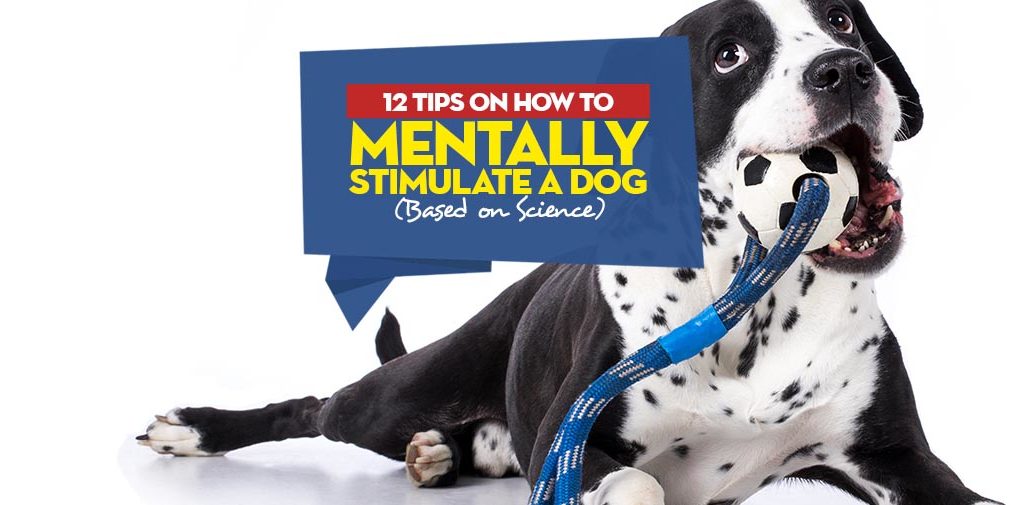While they are technically different species, people have some stark similarities with Man’s Best Friend when it comes to mental health and disorders, particularly boredom, stress, depression, and apathy, as observed in research over the last three decades.
To avoid any negative effects from the lack of stimulation, it's imperative that every pet owner learns how to stimulate a dog for the pet's overall mental well-being, and I'll explain why.
Exposure to different environments, stimulating different sensory receptors, playing games, and teaching dogs new tricks/commands can all be viable methods of mental stimulation for dogs that impact canine behavior, prevent mental disorders, and may even trigger changes.
In most cases, dogs displaying undesirable behaviors can be encouraged through lessons and games to exhibit appropriate behaviors.
Boredom: The Real Danger for Dogs
Oftentimes, proper dog mental stimulation is ignored by pet owners.
But, like us, our dogs can get bored when left alone day after day.
Their environment and routine are the same, and this negatively affects their overall health (Anisman et al. 2005).
While boredom in animals is difficult to assess empirically, many studies do suggest that boredom is closely related to problematic and stereotypical behavior (Wood-Gush et al. 1983; Gunn et al. 1995; Paquette et al. 1988).
Boredom in animals was also observed to be the cause of apathy and depression (Wemelsfelder 1993; Meyer-Holzapfel 1968; Carlstead 1996).
Stress, which can result from boredom, is another factor that has been suggested in studies to cause depression in animals (Maier 1984; Gilmer et al. 2003).
Proper dog mental stimulation using a variety of different methods can decrease the chance of boredom, apathy, and depression in dogs and correct their behavioral problems (Tiira et al. 2012).
Some methods, such as environmental enrichment for the dog, may also make your dog less fearful, less stressed, and less anxious, as shown in several animal species studies (Jones 1982; Klein et al. 1994).
Furthermore, dog mental stimulation approaches can also help deal with obsessive-compulsive disorders in dogs and stress-induced OCD-like behavior in canines (Luescher 2003).
Harmful OCD behavior in dogs, while still a controversial topic, has been suggested to be a result of the lack of enriched environment in many animal species (Overall 2000; Schonecker 2009; Jones et al. 2010).
When you teach your dog the tricks below, you'll get them engaged.
It will boost the pet's mood, get rid of bad and OCD behavior, prevent mental health problems, and it's likely to be fun for you, too.
Not to mention, it will help to strengthen the bond between the two of you.
I've gone through more research to find the best science-based ways to dog mental stimulation with great success. Here they are.
RANKED: Top 50 Best Interactive Dog Toys for Mental Stimulation
12 Tips on How to Mentally Stimulate a Dog
1. Olfactory Stimulation
Compared to humans, dogs have 50 times more olfactory receptors in their noses.
In addition, the part of the brain that analyzes odors is 40 times greater in dogs than in humans (Young et al. 2002).
So, it only makes sense that exposure to various scents will provide mental stimulation for your dog.
A study using olfactory stimulation (control, lavender, chamomile, rosemary, and peppermint) for 4 hrs a day for 5 days on 55 rescue dogs resulted in the dogs resting less and increasing their physical activity.
Less movement was observed with exposure to the lavender and chamomile scents.
In contrast, rosemary and peppermint scents resulted in significantly more standing, moving, and vocalization and less visible signs of boredom and depression (Graham et al. 2005).
This study suggests that olfactory stimulation may enhance the welfare of dogs, especially for those in shelters, and is a viable option for mental stimulation for dogs.
2. Human Social Stimulation
Both in science and life, the relationship between humans and their canine companions is sometimes compared to the relationships that parents have with their children.
Human contact and human socialization, it seems, are important to dogs. And, as previously mentioned, mental stimulation can foster the bond that you have with your pet.
In other words, dogs look to humans for companionship, discipline, protection, and learning.
Human socialization is also the most effective way to reduce excessive barking caused by separation-induced distress in dogs (Pettijohn et al., 1977).
In a rescue center environment, it was shown that human social stimulation resulted in dogs spending more time at the front of the enclosure (which is a sign of curiosity), more time standing, slightly more time barking, and increased chances of being adopted.
In fact, small increases in the opportunity for social interaction with humans produced a beneficial change in the socialization behavior with other dogs (Hubrecht 1993).
RELATED: The Importance of Mental Stimulation for Your Dog
3. Auditory Stimulation
Music, it seems, has the power to sway the attitudes of a dog. Exposure to different types of music can lead to changes in behavior in dogs and provide mental stimulation for dogs.
Classical music, for example, can be seen as a benefit for dogs as it can help with relaxation and increase quiet time, making them easier to adopt (Wells et al. 2002).
In contrast, heavy metal music encourages dogs to spend more time barking.
Interestingly, harp music seems to have the same effect on dogs as they did on the ancient Greek and Roman aristocracy of old. Reduced stress is one of the effects of playing harp music around dogs (Boone et al. 2003; PDF).
This is seen by the decrease in physiological measures, such as heart rate and respiration rate.
Another study showed that dogs responded to 5-10 minutes of sound exposure at 80dB with a transient increase in blood sugar.
It should be noted that when you're attempting to stimulate your dog mentally, different breeds may respond differently to auditory stimulation, such as specific songs.
For example, larger breeds expressed greater interest in harp music compared to smaller breeds.
4. Dog Toys
A study of the effectiveness of five toys — squeaky ball, non-squeaky ball, Nylabone chew, tug rope, and Boomer ball — was evaluated on 32 adult dogs in a rescue shelter where each toy was given to the dogs for 6 days (Wells 2004).
Observations showed that despite having access to the toys, less than 8% of the time was spent playing with toys, with more preference given to the Nylabone chew.
Interest in dog toys decreased over time, but habituation to the Nylabone was slower.
Dogs spent more time moving and less time standing with exposure to the Nylabone chew, squeaky ball, and non-squeaky ball.
Even “toys” as simple as cardboard boxes and coconuts can result in proper mental stimulation for dogs, decreased yawning frequencies, and time spent lying down and sitting down (Kiddie et al. 2006).
Toys should be rotated to encourage exploration and reduce habituation.
5. Food Enrichment Toys
We all know that food works well. Food enrichment toys, such as rawhide chews, can provide mental stimulation for your dog.
The popular Kong dog toys, such as the ‘Kong Extreme’, a rubber toy that can be stuffed with dog treats, have been proven to stimulate appetite behavior, increase the level of activity and exercise, and lower the frequency of barking (Schipper et al. 2008).
Other dog chews and dog toys, such as Rawhide and Gumabone, can result in dogs spending less time resting and looking outside their pen.
Unlike regular toys for dogs, specifically dog chews showed less habituation and boredom with the toy after 2 months (Hubrecht 2003).
After exposure to food toys, inactivity in dogs can be reduced by 30%.
6. Interaction with other Dogs
Dogs were descended from wolves, which were inherently pack animals.
This mindset has unerringly flowed through the course of evolution, which is why socialization has been seen to deliver many benefits to canines.
Bringing in another canine can help.
For example, dogs that are solitary are typically more inactive (72-85% of the time being inactive), compared to only 4-5% of the inactive time when group-housed with other dogs (Hubrecht et al. 1992).
Separation from littermates can also result in distress vocalizations, where the presence of a littermate can reduce the vocalizations by 50-90%.
Dogs use play as a means of establishing relationships with other dogs. Dogs can also derive social information from observing play between third parties.
In fact, social play in puppies plays a role later in life in setting up the social organization of adult dogs (Bradshaw et al. 2015).
For dogs in a group, socialization requires a combination of learning, competition, and cooperation.
Oftentimes, chase and tackle play results in role reversals, indicating that dogs are able to equalize their behavior to maintain a playful atmosphere.
Self-handicapping is also a dog’s way of communicating playful intent.
Physical contact with other dogs may not even be necessary.
Visual contact with other dogs housed in adjacent cages can provide great mental stimulation for dogs and decrease yawning frequency and time spent lying down.
7. Games for Dogs
Dogs love to play games like fetch, as it stimulates physical activity, but this can also be challenging.
Dogs that play the rough-and-tumble game score higher in dominance-related factors but lower in separation-related behavior.
Dogs that play tug-of-war and fetch games, however, score high in confidence (Rooney et al. 2010).
Dogs don’t play games to win or lose.
They play it because it is a physical and mental outlet, which is reflected in the confidence test scores, which did not change regardless of whether the dog won or lost in the game.
There are a ton of games for dogs to try, and remember that when these games are unavailable to dogs, they may resort to entertaining themselves through compulsive or destructive behaviors.
8. Exercise
Doing sports with your dog is recommended. Exercise can offer obvious health benefits for dogs, such as improvements in the cardiovascular system, joints, and respiratory system.
However, exercise can also improve cognitive performance in canines, with this improvement continuing even after exercise has ended.
Following 3 weeks of running exercises, animals had better memory performance and a significant increase in hippocampal brain-derived neurotrophic factor, suggesting that exercise has brain plasticity effects (Berchtold et al. 2009).
For the best results, in addition to walking, activities like running, playing fetch with a ball or Frisbee disk, and swimming should be added to your dog’s exercise routine when you're learning how to mentally stimulate a dog to avoid any bad behaviors or boredom in your canine.
9. Training & Learning New Things
Training and learning during early life are critically important for proper dog mental stimulation and development.
For example, studies on rats and dogs show that restricting early experience, such as the removal of an enriched environment and learning new things, will result in poor performance on tests related to learning ability and intelligence as adults (Thompson et al. 1954).
A similar study where animals were restricted in early experiences shows that there is a deficit in problem-solving ability and impeding the development of intellect maturity in Scottish terriers.
Learning in early life can contribute greatly not only to mental stimulation for dogs but also to the dog’s personality, with complex individual differences of emotion and motivation.
Rats reared in an environment with obstacles and blind alleys created opportunities for problem-solving and learning during growth (Hebb 1955).
It is best to avoid teaching boring or repetitive activities. A combination of training activities, such as discipline and simple agility training exercises, will be beneficial to keep your dog’s mind sharp.
ALSO READ: 12 Signs Your Dog Is Stressed
10. Visual Stimulation
One study looked at 5 types of visual stimulation (no stimulation, blank television screen, moving televised images of other dogs, interspecific (unfamiliar animal species), and humans to determine its effect on the behavior of 50 dogs in a rescue shelter (Graham et al. 2005).
Dogs spent little time (10.8%) looking at blank television monitors but spent more time looking at images of other dogs, humans, and interspecifics.
When it comes to mental stimulation for dogs using visuals, canines were most attracted to images of interspecifics, followed by other dogs and humans.
All visual stimuli encouraged significantly less vocalization and movement than when provided with no visual stimulation.
11. Going Outdoors
Changing your pet’s surroundings is important and beneficial to your canine's health, and it's one of the most effective ways to engage the dog.
Hiking and camping can all be incorporated into your routine of dog mental stimulation. The sights, sounds, and smells of the outdoors keep your dog active and your dog’s mind alert.
The outdoors can foster opportunities for creativity, imagination, social connections, and learned behaviors.
Outdoor play has a positive effect on social development, motor skill development, and attention and activity levels in children (Parsons 2011; PDF).
An enriched environment like the outdoors can offer visual, olfactory, and auditory stimulation for your dog.
Even in animals that were restricted early in life and have learning deficits, it is possible to reverse this effect with experiences later in life.
A study showed that animals exposed to later life “free” environments, like being exposed to the outdoors, could reverse the effect of early restrictions and perform as well as animals exposed to a free environment early in life (Bernstein 1972).
12. Puppy Play
Play is where puppies learn basic manners.
Play is just as important as socialization in the dog's early years, and it offers dogs the opportunity to keep physically fit and mentally challenged.
A study of 4000 dog owners showed that 20% of owners play with their dog 6 times per day, 50% play with their dog 2-3 times per day, and 10% play with their dog only once per day (Rooney et al. 2012).
Dogs that had reduced play time had more behavioral issues, including anxiety, whining, and aggression.
When people think of a dog’s health, the natural tendency is to focus on the physical health of the dog, which is understandable. It is the easiest to diagnose, and various treatments exist for any issues that may arise.
However, focusing on a canine's mental health and proper dog mental stimulation is equally important.
Utilizing proper ways of mental stimulation for dogs, an owner is on their way to ensuring that their pup's brain is in a heightened state of plasticity, allowing the dog to adopt and learn.
13. Anything Else?
Proper dog mental stimulation will benefit your dog in more ways than you can observe.
What approach have you taken to ensure your Fido is never bored, and what tricks have you learned about mental stimulation for dogs in your own household?
READ NEXT: Dog Facial Expressions and Body Language Explained by Science


















